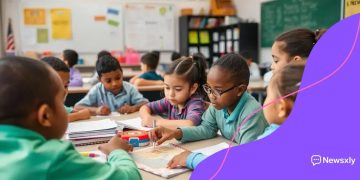Education recovery: paving the way for a brighter future

Education recovery involves implementing strategic initiatives that restore and enhance learning, with a focus on community involvement, innovative methods, and measurable success through key performance indicators.
Education recovery plays a vital role in revitalizing our learning systems, especially in today’s rapidly changing environment. Have you ever wondered how we can rebuild education to better serve students and communities? In this article, we will delve into actionable strategies that can transform education for the better.
Understanding the concept of education recovery
Understanding education recovery is essential for revitalizing our learning environments, especially after disruptions. This concept involves implementing strategies to restore and enhance education systems that may have fallen behind.
Key Components of Education Recovery
To effectively grasp the idea of education recovery, we need to explore critical areas such as:
- Curriculum Adjustments: Updating and modifying teaching materials to meet current demands.
- Teacher Training: Providing ongoing support and resources for educators to improve their skills.
- Student Engagement: Finding innovative ways to keep students motivated and involved in their learning processes.
Next, it’s vital to consider how education recovery impacts different stakeholders. For example, students need personalized support to regain their footing after disruptions. Furthermore, schools require sufficient funding to implement these recovery strategies successfully.
Community Involvement
Education recovery cannot happen in isolation. Community support plays a crucial role in revitalizing schools. By collaborating with families and community organizations, schools can create a more robust educational framework. Thus, stronger partnerships lead to enhanced resources, ensuring students return to a supportive learning atmosphere.
Additionally, a flexible approach can adapt to the unique needs of each student. Policies should promote inclusivity, ensuring that all learners, especially those disadvantaged, have equal access to recovery resources. This aspect is vital to fostering a sense of belonging and success across diverse student populations.
Overall, understanding education recovery entails embracing the collaborative effort to rebuild and transform education systems. By focusing on key components and engaging communities, we can pave the way for a robust and resilient learning environment.
Key challenges in education recovery
When discussing education recovery, it is crucial to acknowledge the key challenges that arise. These obstacles can significantly hinder the effectiveness of recovery efforts and require dedicated attention.
Identifying Major Challenges
One major challenge is funding. Many schools face budget cuts, which can limit their ability to implement necessary recovery programs. Without sufficient financial resources, it is hard to provide the tools and support needed for effective learning.
- Resource Allocation: Ensuring that funds are distributed effectively across schools.
- Technology Access: Providing equal access to technology for all students to enhance learning.
- Staffing Issues: Recruiting and retaining qualified educators able to support recovery efforts.
Another notable challenge is student engagement. After significant disruptions, many students may feel disconnected from their education and hesitant to return to a structured learning environment. Addressing their mental health needs is vital for fostering a positive attitude toward school.
Cultural Awareness and Inclusivity
In addition to funding and engagement, schools must navigate the challenges posed by cultural awareness and inclusivity. Different student backgrounds can affect how recovery programs are perceived and accepted. Understanding these cultural differences is essential for designing effective strategies.
Schools also face the ongoing challenge of adapting curricula. As learning environments shift, educators need to update their teaching methods and materials frequently. This adaptability is crucial for meeting the diverse needs of students and ensuring that they receive an equitable education.
Ultimately, while education recovery presents several hurdles, addressing these challenges can lead to more effective and inclusive learning environments. By focusing on funding, engagement, cultural awareness, and curricular adaptability, schools can foster resilience and growth in their students.
Innovative approaches to enhance learning

Innovative approaches to enhance learning are essential in today’s educational landscape. These strategies aim to engage students more deeply and foster a love for learning. With these new methods, schools can create vibrant and effective educational environments.
Integrating Technology in the Classroom
One of the most significant innovations is integrating technology into lessons. Using tools like tablets and educational apps can make learning interactive. This approach helps students grasp complex concepts with greater ease.
- Interactive Learning: Use apps that allow students to practice skills in real time.
- Virtual Reality: Implement VR experiences to explore topics in immersive ways.
- Online Resources: Utilize platforms offering a wealth of information and activities accessible anytime.
Furthermore, project-based learning is another innovative way to enhance engagement. This method encourages students to work on long-term projects that relate to real-world problems. It helps develop critical thinking skills while allowing creativity to flourish.
Collaborative Learning Environments
Creating a collaborative learning environment can greatly improve student motivation. Group work allows students to share ideas and learn from each other. In this setting, they feel supported and can take more ownership of their learning process.
Additionally, flipping the classroom is an emerging trend where traditional teaching is turned upside down. Students learn new content at home, like watching videos, and engage in discussions and activities in class. This method maximizes classroom time for practical application.
Moreover, personalized learning plans are gaining traction. By tailoring education to meet individual needs and learning styles, educators can better support each student. With data-driven insights, teachers can adapt their approaches to provide the appropriate challenges and support.
As innovations emerge, it’s vital to keep updating teaching methods. By exploring and implementing these innovative approaches, educators can create rich learning experiences, nurturing a culture of curiosity and growth in students.
Community involvement in education recovery
Community involvement in education recovery is crucial for building a strong foundation for students. When communities come together to support their schools, they create environments where learners can thrive.
Benefits of Community Engagement
Engaging the community in education recovery has many benefits. These include increased resources, enhanced support systems, and better outcomes for students.
- Resource Sharing: Communities can provide additional resources like funding, facilities, and volunteers to support school programs.
- Encouraging Partnerships: Collaboration between schools and local businesses can lead to internships and job opportunities for students.
- Family Engagement: Actively involving families helps create a network of support that fosters student success.
Another important aspect of community involvement is the development of mentorship programs. By connecting students with local mentors, schools can offer guidance and real-world experience, enhancing students’ skills and confidence.
Ways to Foster Community Participation
To encourage community participation, schools can organize events that invite families and local organizations to collaborate. Activities such as community forums, workshops, and volunteer days can strengthen these ties.
Creating communication channels is also essential. Schools should use social media, newsletters, and websites to keep the community informed about needs and opportunities for engagement. This will foster transparency and open dialogue among stakeholders.
Acknowledging and celebrating community contributions helps strengthen these relationships. Schools can highlight local partners through awards or recognition events, showing appreciation for their support.
By promoting a culture of community involvement, schools can better navigate the challenges of recovery. With collective efforts and resources, students will have the chance to succeed and flourish in their educational journeys.
Measuring success in education recovery initiatives
Measuring success in education recovery initiatives is crucial for understanding their impact. By evaluating these programs, schools can identify what works and what needs improvement.
Key Performance Indicators
One way to measure success is through key performance indicators (KPIs). These metrics help assess different aspects of education recovery. Common KPIs include:
- Student Attendance: Tracking changes in attendance rates can show how effective recovery efforts are.
- Academic Performance: Comparing test scores and grades before and after initiatives provides insight into academic improvements.
- Engagement Levels: Monitoring student participation in activities can highlight whether students feel connected to their learning.
Collecting data on these KPIs regularly allows educators to see trends over time. This continuous process helps identify areas that require attention and adjustment.
Surveys and Feedback
Another effective method of measuring success involves gathering feedback from students, parents, and teachers. Surveys can provide valuable information about the perception of various initiatives.
Questions may focus on how accessible resources are, how supported students feel, and whether they notice improvements in their learning environments. This qualitative data is essential in understanding the broader impact of recovery efforts.
Additionally, focus groups or interviews can provide deeper insights into experiences. Through open discussions, stakeholders can express their thoughts, contributing to a more comprehensive evaluation.
Ultimately, measuring success in education recovery requires a blend of quantitative data and qualitative feedback. By employing both methods, schools can create a complete picture of their recovery initiatives, leading to more informed decisions and better outcomes for students.
In conclusion, successful education recovery initiatives require a collaborative effort from communities, educators, and stakeholders. By measuring success through key performance indicators, gathering feedback, and adapting strategies, schools can create effective and engaging learning environments for all students. Fostering community involvement and embracing innovative teaching methods will pave the way for a brighter educational future. The journey to recovery is ongoing, and together we can ensure that every student has the opportunity to succeed.
FAQ – Questions about Education Recovery Initiatives
What is education recovery?
Education recovery involves implementing strategies to restore and enhance educational experiences after disruptions.
Why is community involvement important in education recovery?
Community involvement provides additional resources, support, and opportunities for collaboration that can enhance student learning.
How can success be measured in education recovery initiatives?
Success can be measured through key performance indicators (KPIs), student feedback, and observations of engagement levels.
What innovative methods can be used to enhance learning?
Innovative methods include integrating technology, project-based learning, and personalized learning plans to meet individual student needs.





